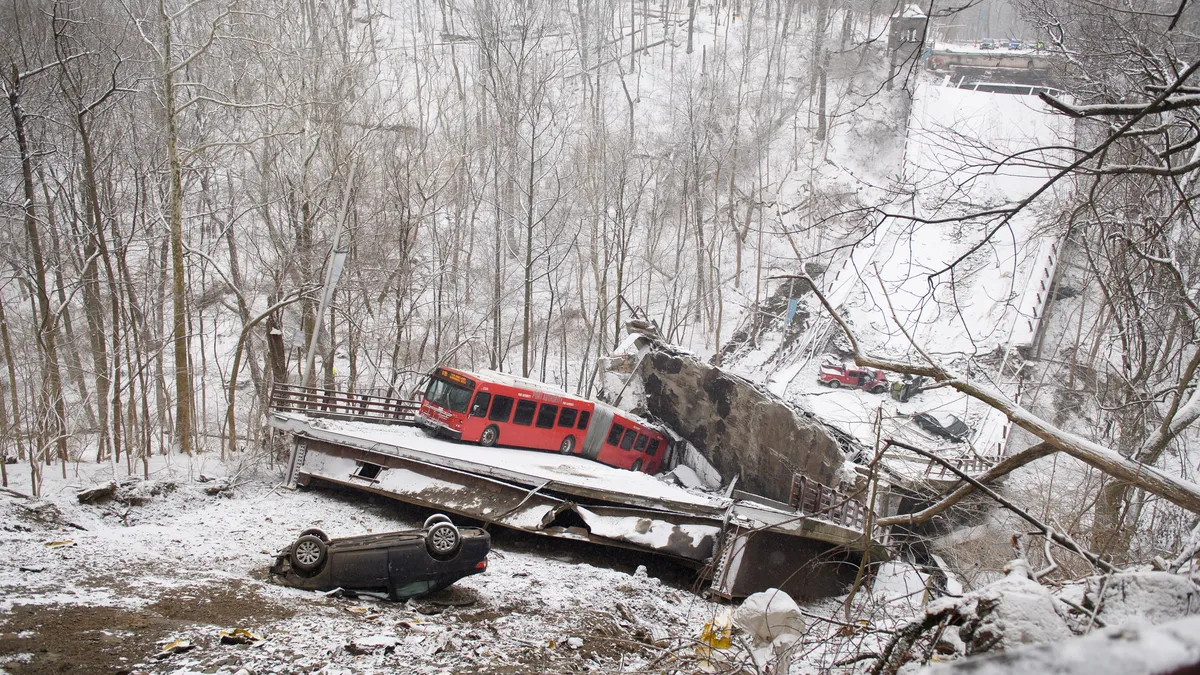In a scathing May report, the National Transportation Safety Board said lack of maintenance caused the January 2022 collapse of Pittsburgh’s Fern Hollow Bridge, a catastrophe that injured 10 people, four of them seriously.
Besides investigating what went wrong at Fern Hollow, the group inspected 10 similar uncoated weathering steel Pennsylvania bridges and found the same kinds of maintenance problems. They sounded the alarm that, nationwide, 10,000 bridges are similarly at risk.
In the midst of fingerpointing as to who is responsible for Fern Hollow, the fact remains that thousands of bridges in the U.S., not just uncoated weathering steel ones, are in danger of collapse. A separate report from the U.S. DOT found that more than 46,000 spans — about 7.5% of the country’s bridges — are in “poor” condition, as Fern Hollow was rated before it fell.
“The scope of the problem is a maintenance problem,” said Chris Garrell, chief bridge engineer of the National Steel Bridge Alliance, a group that also recently put out a call to action to make bridge maintenance and repairs a priority. “This is like having a wound on your leg that you never seek any medical attention. Eventually it’s going to get bad, you’re going to lose the leg, and you’re going to fall down.”
Multiple inspections, but little action
In its report, the NTSB found that drainage problems led to the metal legs of the Fern Hollow Bridge corroding over time. The problems with the bridge weren’t a surprise — or shouldn’t have been — as it had been inspected multiple times. It had not had an overall rating better than “fair” from the Federal Highway Administration since 1989, and had a poor rating for 10 years.
The NTSB also stated that every inspection done from 2005 until four months before the collapse noted holes in the bridge’s steel legs, but regular maintenance, like clearing debris, dirt and leaves, was not regularly done, despite inspectors’ warnings. Lack of maintenance is a major problem in the U.S., said Garrell.
America’s bridges are generally old, which makes this kind of regular maintenance critical. The construction of the Interstate Highway System, which created highway infrastructure as we know it, kicked off in 1956 and many of those roadways, bridges included, are still in place. Currently, 42% of the country’s bridges are at least 50 years old, according to the American Society of Civil Engineers.
The first Fern Hollow Bridge opened in 1901, and was then replaced in 1973 with the structure that fell. That’s nearly 50 years of wear and tear, and since at least 2005, deferred maintenance.
“The expected lifespan of a highway bridge is 50 to 75 years,” said Juan Carlos Araiza, senior vice president at EFI Global. Araiza investigates bridge failures, though he did not work on this one. “The moment you exceed those lifespans, you would expect to have to do either major repair or the capacity of the bridge to go down.”
Most at risk
Not every bridge is at the same level of risk. Those that receive regular inspections, maintenance and funding for maintenance are less likely to be a problem, as are those located in dry climates. Bridges in areas that experience cold weather, humidity and/or frequent weather changes are more likely to be in trouble, as are those in coastal areas, said Garrell.
Temperature changes mean that components of the bridge will expand and contract, which adds to wear and tear. With deicing agents, salt “collects in scuppers or downspouts, which are then put through pipes and evacuated below the bridge, like a kind of sewage system,” he said. “When pipes break down, all that concentrated salt is going into locations where it’s probably not supposed to be.”
This situation can be exacerbated on bridges that span roadways. “The traffic driving on the bridge is kicking up salt spray that’s dissolved on the roadway,” said Jennifer McConnell, professor of civil and environmental engineering at the Center of Innovative Bridge Engineering at the University of Delaware. That’s how the process is designed to work, but it’s also “kicking up this mist onto the structure members underneath the bridge.”
Another segment of bridges particularly at corrosion risk are those close enough to the ocean where one can see the water, she added.
What can solve this problem?
While the NTSB report focused on uncoated weathered steel bridges, the scope of the problem extends far beyond just one type, said Garrell. Inspections are happening, as the NTSB found in its report on Fern Hollow, but the findings from them are often not followed through. “If you do not do maintenance, then this is the result,” he said.
Consistency in responsibility for bridge inspections can help, but in many states, including Pennsylvania, who is responsible for what is a mix. A bridge might be owned by a city, the state, a public transportation authority like the Southeastern Pennsylvania Transportation Authority or another entity like the Pennsylvania Turnpike Commission.
While subcontractors don’t design bridges, and are often directed in their bridge and highway work, they can learn to spot red flags during the construction process, like water accumulating on stiffener plates. Araiza also suggested that subcontractors who want to be part of the solution in addressing bridge corrosion and maintenance get a good understanding of bridge-related problems in their area.
“Find expertise, and position yourself to do this type of work. It’s really important to understand where the work is,” Araiza said



















